Feasibility of Low Carbon Renewable Energy City Integrated with Hybrid Renewable Energy Systems
Abstract
:1. Introduction
2. Methodology
2.1. Model Development
2.1.1. Thermal and Electric Loads
2.1.2. Photovoltaic System and Power Converter
2.1.3. Battery
2.1.4. Power Converter
2.1.5. Natural Gas (NG) Generator
2.1.6. Solar Thermal System and Thermal Energy Storage
2.2. Optimization Framework
3. Simulation
3.1. Case Study Site: Sejong National Pilot Smart City
3.2. Load Profile
3.3. Simulation Cases
4. Results and Discussion
4.1. Base Case: NG Generator
4.2. Case 1: Hybrid NG Generator, PV and ESS System
4.3. Case 2: Hybrid NG Generator, PV, ESS, and Solar Thermal System
4.4. Comparison of Carbon Emission and Economic Performance
4.5. Discussion and Future Works
5. Conclusions
Author Contributions
Funding
Institutional Review Board Statement
Informed Consent Statement
Conflicts of Interest
References
- Byrne, J.; Taminiau, J.; Kurdgelashvili, L.; Kim, K.N. A Review of the Solar City Concept and Methods to Assess Rooftop Solar Electric Potential, with an Illustrative Application to the City of Seoul. Renew. Sustain. Energy Rev. 2015, 41, 830–844. [Google Scholar] [CrossRef]
- Taminiau, J.; Byrne, J.; Kim, J.; Kim, M.; Seo, J.; Korea, S. Infrastructure-Scale Sustainable Energy Planning in the Cityscape: Transforming Urban Energy Metabolism in East Asia. Wiley Interdiscip. Rev. Energy Environ. 2021, 10, e397. [Google Scholar] [CrossRef]
- Capellán-Pérez, I.; de Castro, C.; Arto, I. Assessing Vulnerabilities and Limits in the Transition to Renewable Energies: Land Requirements under 100% Solar Energy Scenarios. Renew. Sustain. Energy Rev. 2017, 77, 760–782. [Google Scholar] [CrossRef] [Green Version]
- Chen, Y.; Hong, T.; Piette, M.A. Automatic generation and simulation of urban building energy models based on city datasets for city-scale building retrofit analysis. Appl. Energy 2017, 205, 323–335. [Google Scholar] [CrossRef] [Green Version]
- Mastrucci, A.; Baume, O.; Stazi, F.; Leopold, U. Estimating energy savings for the residential building stock of an entire city: A GIS-based statistical downscaling approach applied to Rotterdam. Energy Build. 2014, 75, 358–367. [Google Scholar] [CrossRef]
- Shahrokni, H.; Levihn, F.; Brandt, N. Big meter data analysis of the energy efficiency potential in Stockholm’s building stock. Energy Build. 2014, 78, 153–164. [Google Scholar] [CrossRef]
- Bagheri, M.; Delbari, S.H.; Pakzadmanesh, M.; Kennedy, C.A. City-Integrated Renewable Energy Design for Low-Carbon and Climate-Resilient Communities. Appl. Energy 2019, 239, 1212–1225. [Google Scholar] [CrossRef]
- De Oliveira e Silva, G.; Hendrick, P. Lead–Acid Batteries Coupled with Photovoltaics for Increased Electricity Self-Sufficiency in Households. Appl. Energy 2016, 178, 856–867. [Google Scholar] [CrossRef]
- Lund, H.; Werner, S.; Wiltshire, R.; Svendsen, S.; Thorsen, J.E.; Hvelplund, F.; Mathiesen, B.V. 4th Generation District Heating (4GDH). Integrating Smart Thermal Grids into Future Sustainable Energy Systems. Energy 2014, 68, 1–11. [Google Scholar] [CrossRef]
- Sommer, T.; Sulzer, M.; Wetter, M.; Sotnikov, A.; Mennel, S.; Stettler, C. The Reservoir Network: A New Network Topology for District Heating and Cooling. Energy 2020, 199, 117418. [Google Scholar] [CrossRef]
- Schmidt, T.; Pauschinger, T.; Sørensen, P.A.; Snijders, A.; Djebbar, R.; Boulter, R.; Thornton, J. Design Aspects for Large-Scale Pit and Aquifer Thermal Energy Storage for District Heating and Cooling. Energy Procedia 2018, 149, 585–594. [Google Scholar] [CrossRef]
- Connolly, D.; Lund, H.; Mathiesen, B.V.; Werner, S.; Möller, B.; Persson, U.; Boermans, T.; Trier, D.; Østergaard, P.A.; Nielsen, S. Heat Roadmap Europe: Combining District Heating with Heat Savings to Decarbonise the EU Energy System. Energy Policy 2014, 65, 475–489. [Google Scholar] [CrossRef]
- Hast, A.; Syri, S.; Lekavičius, V.; Galinis, A. District Heating in Cities as a Part of Low-Carbon Energy System. Energy 2018, 152, 627–639. [Google Scholar] [CrossRef]
- Elkadeem, M.R.; Wang, S.; Sharshir, S.W.; Atia, E.G. Feasibility Analysis and Techno-Economic Design of Grid-Isolated Hybrid Renewable Energy System for Electrification of Agriculture and Irrigation Area: A Case Study in Dongola, Sudan. Energy Convers. Manag. 2019, 196, 1453–1478. [Google Scholar] [CrossRef]
- Weinand, J.M.; Scheller, F.; McKenna, R. Reviewing Energy System Modelling of Decentralized Energy Autonomy. Energy 2020, 203, 117817. [Google Scholar] [CrossRef]
- Kim, M.-H.; Lee, D.-W.; Kim, D.-W.; An, Y.-S.; Yun, J.-H. Energy Performance Investigation of Bi-Directional Convergence Energy Prosumers for an Energy Sharing Community. Energies 2021, 14, 5544. [Google Scholar] [CrossRef]
- Kim, M.H.; An, Y.; Joo, H.J.; Lee, D.W.; Yun, J.H. Self-Sufficiency and Energy Savings of Renewable Thermal Energy Systems for an Energy-Sharing Community. Energies 2021, 14, 4284. [Google Scholar] [CrossRef]
- Herrando, M.; Pantaleo, A.M.; Wang, K.; Markides, C.N. Solar Combined Cooling, Heating and Power Systems Based on Hybrid PVT, PV or Solar-Thermal Collectors for Building Applications. Renew. Energy 2019, 143, 637–647. [Google Scholar] [CrossRef]
- Pathak, M.J.M.; Sanders, P.G.; Pearce, J.M. Optimizing Limited Solar Roof Access by Exergy Analysis of Solar Thermal, Photovoltaic, and Hybrid Photovoltaic Thermal Systems. Appl. Energy 2014, 120, 115–124. [Google Scholar] [CrossRef] [Green Version]
- Wang, K.; Herrando, M.; Pantaleo, A.M.; Markides, C.N. Technoeconomic Assessments of Hybrid Photovoltaic-Thermal vs. Conventional Solar-Energy Systems: Case Studies in Heat and Power Provision to Sports Centres. Appl. Energy 2019, 254, 113657. [Google Scholar] [CrossRef]
- Wijeratne, W.M.P.U.; Yang, R.J.; Too, E.; Wakefield, R. Design and Development of Distributed Solar PV Systems: Do the Current Tools Work? Sustain. Cities Soc. 2019, 45, 553–578. [Google Scholar] [CrossRef]
- Lozano, L.; Querikiol, E.M.; Abundo, M.L.S.; Bellotindos, L.M. Techno-Economic Analysis of a Cost-Effective Power Generation System for off-Grid Island Communities: A Case Study of Gilutongan Island, Cordova, Cebu, Philippines. Renew. Energy 2019, 140, 905–911. [Google Scholar] [CrossRef]
- Lim, J.Y.; How, B.S.; Rhee, G.; Hwangbo, S.; Yoo, C.K. Transitioning of Localized Renewable Energy System towards Sustainable Hydrogen Development Planning: P-Graph Approach. Appl. Energy 2020, 263, 114635. [Google Scholar] [CrossRef]
- Zubair, M.; Bilal Awan, A.; Al-Ahmadi, A.; Abo-Khalil, A.G. NPC Based Design Optimization for a Net Zero Office Building in Hot Climates with PV Panels as Shading Device. Energies 2018, 11, 1391. [Google Scholar] [CrossRef] [Green Version]
- Nyoni, K.J.; Maronga, A.; Tuohy, P.G.; Shane, A.; Leonowicz, Z. Hydro-Connected Floating PV Renewable Energy System and Onshore Wind Potential in Zambia. Energies 2021, 14, 5330. [Google Scholar] [CrossRef]
- Shah, K.K.; Mundada, A.S.; Pearce, J.M. Performance of U.S. Hybrid Distributed Energy Systems: Solar Photovoltaic, Battery and Combined Heat and Power. Energy Convers. Manag. 2015, 105, 71–80. [Google Scholar] [CrossRef] [Green Version]
- Luerssen, C.; Gandhi, O.; Reindl, T.; Sekhar, C.; Cheong, D. Life Cycle Cost Analysis (LCCA) of PV-Powered Cooling Systems with Thermal Energy and Battery Storage for off-Grid Applications. Appl. Energy 2020, 273, 115145. [Google Scholar] [CrossRef]
- Medved, S.; Domjan, S.; Arkar, C. Contribution of Energy Storage to the Transition from Net Zero to Zero Energy Buildings. Energy Build. 2021, 236, 110751. [Google Scholar] [CrossRef]
- Morvaj, B.; Evins, R.; Carmeliet, J. Decarbonizing the Electricity Grid: The Impact on Urban Energy Systems, Distribution Grids and District Heating Potential. Appl. Energy 2017, 191, 125–140. [Google Scholar] [CrossRef]
- Le Guen, M.; Mosca, L.; Perera, A.T.D.; Coccolo, S.; Mohajeri, N.; Scartezzini, J.L. Improving the Energy Sustainability of a Swiss Village through Building Renovation and Renewable Energy Integration. Energy Build. 2018, 158, 906–923. [Google Scholar] [CrossRef]
- Kim, M.-H.; Kim, D.; Heo, J.; Lee, D.-W. Energy performance investigation of net plus energy town: Energy balance of the Jincheon eco-friendly energy town. Renew. Energy 2020, 147, 1784–1800. [Google Scholar] [CrossRef]
- Kim, M.H.; Kim, J.K.; Lee, K.H.; Baek, N.C.; Park, D.Y.; Jeong, J.W. Performance Investigation of an Independent Dedicated Outdoor Air System for Energy-plus Houses. Appl. Therm. Eng. 2019, 146, 306–317. [Google Scholar] [CrossRef]
- Duffie, J.A.; Beckman, W.A.; Blair, N. Solar Engineering of Thermal Processes, Photovoltaics and Wind; John Wiley & Sons: Hoboken, NJ, USA, 2020; ISBN 1119540283. [Google Scholar]
- Energy, H. HOMER Pro Version 3.14 User Manual; HOMER Energy: Boulder, CO, USA, 2020; p. 7. [Google Scholar]
- Vimmerstedt, L.; Akar, S.; Mirletz, B.; Stright, D.; Augustine, C.; Beiter, P.; Cohen, S.; Cole, W.; Duffy, P.; Feldman, D.; et al. Annual Technology Baseline: The 2021 Electricity Update; No. NREL/PR-6A20-80095; National Renewable Energy Lab (NREL): Golden, CO, USA, 2021. [Google Scholar]
- Mollenhauer, E.; Christidis, A.; Tsatsaronis, G. Evaluation of an Energy-and Exergy-Based Generic Modeling Approach of Combined Heat and Power Plants. Int. J. Energy Environ. Eng. 2016, 7, 167–176. [Google Scholar] [CrossRef] [Green Version]
- Gonzalez-Salazar, M.A.; Kirsten, T.; Prchlik, L. Review of the Operational Flexibility and Emissions of Gas- and Coal-Fired Power Plants in a Future with Growing Renewables. Renew. Sustain. Energy Rev. 2018, 82, 1497–1513. [Google Scholar] [CrossRef]
- Korea Gas Corporateion (KOGAS). Available online: https://www.kogas.or.kr:9450/eng/index.do (accessed on 16 October 2021).
- Kim, M.-H.; Kim, D.; Heo, J.; Lee, D.-W. Techno-economic analysis of hybrid renewable energy system with solar district heating for net zero energy community. Energy 2019, 187, 115916. [Google Scholar] [CrossRef]
- International Renewable Energy Agency. Renewable Power Generation Costs in 2020; IRNA: Teheran, Iran, 2021; ISBN 978-92-9260-348-9. [Google Scholar]
- Choi, J.; Kim, H.M. Chapter 4—State-of-the-Art of Korean Smart Cities: A Critical Review of the Sejong Smart City Plan. Smart Cities Technol. Soc. Innov. 2021, 51–72. [Google Scholar] [CrossRef]
- The National Pilot Smart City. Available online: https://smartcity.go.kr/en/%ED%94%84%EB%A1%9C%EC%A0%9D%ED%8A%B8/%EA%B5%AD%EA%B0%80%EC%8B%9C%EB%B2%94%EB%8F%84%EC%8B%9C/%EC%84%B8%EC%A2%85-5-1%EC%83%9D%ED%99%9C%EA%B6%8C/ (accessed on 4 October 2021).
- Lee, K.-R.; Lee, Y.-S.; Kim, J.-H. Evaluation on the Photovoltaic Module Arrangement Planning Considering Shading Conditions in Apartment Buildings. J. Archit. Inst. Korea Struct. Constr. 2019, 35, 169. [Google Scholar] [CrossRef]

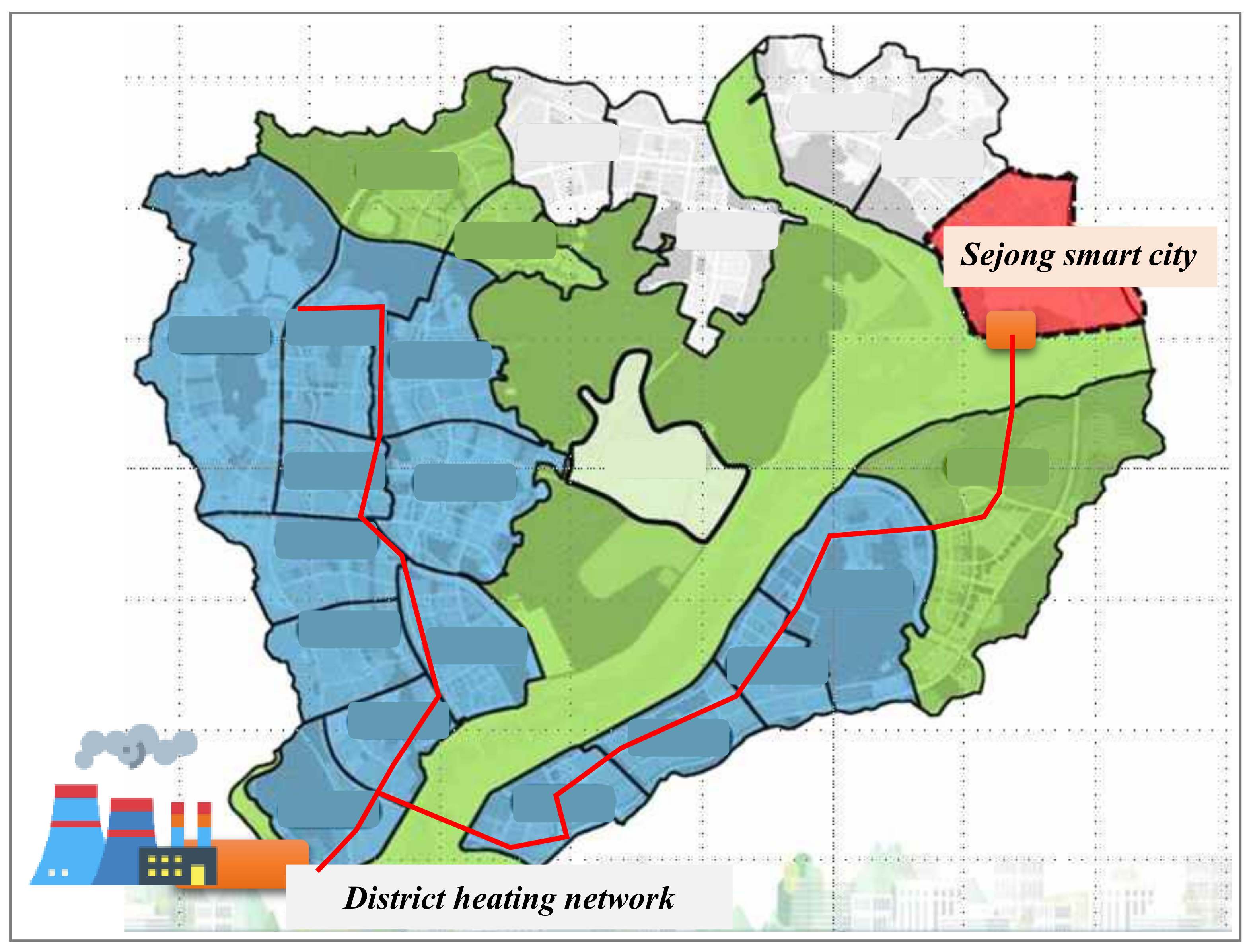
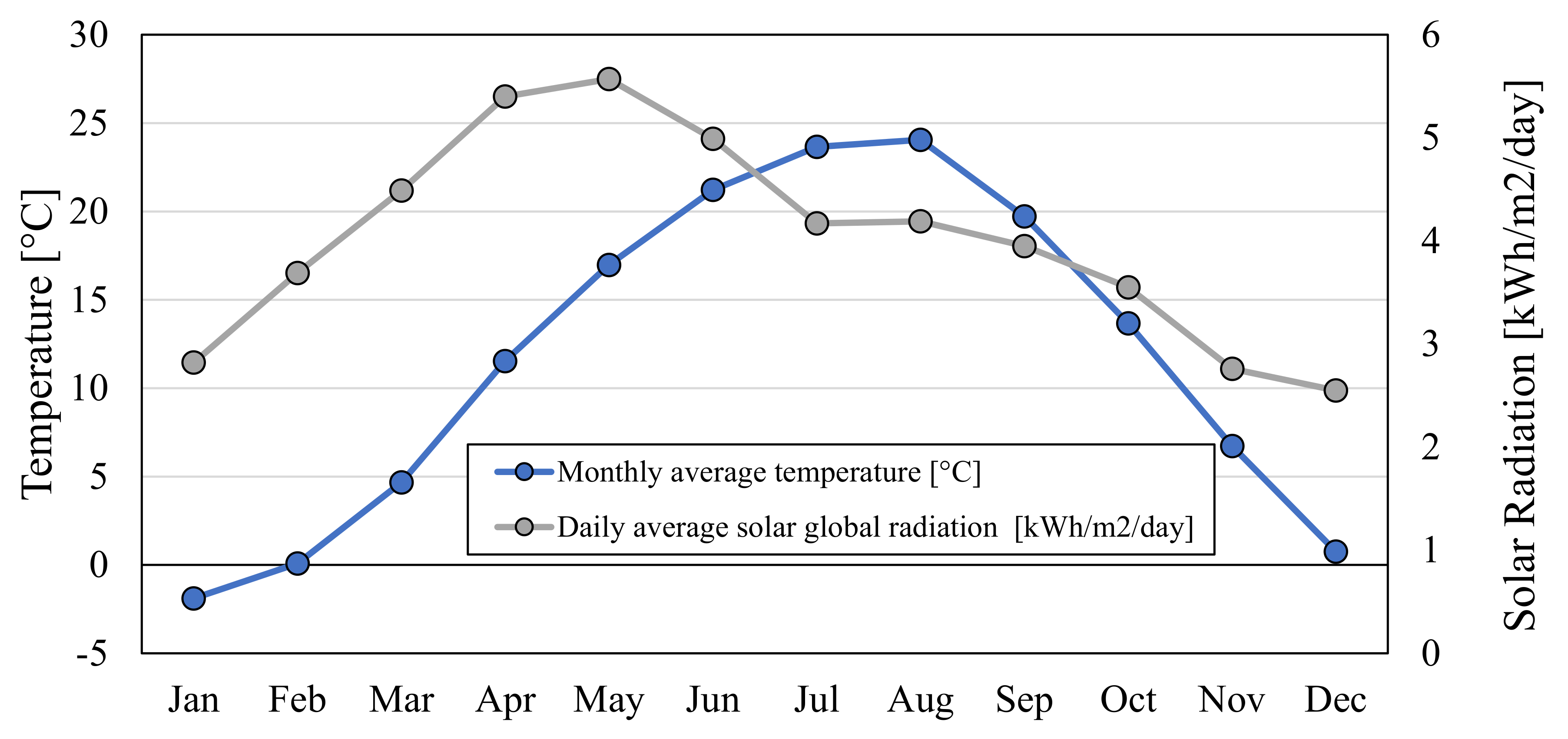
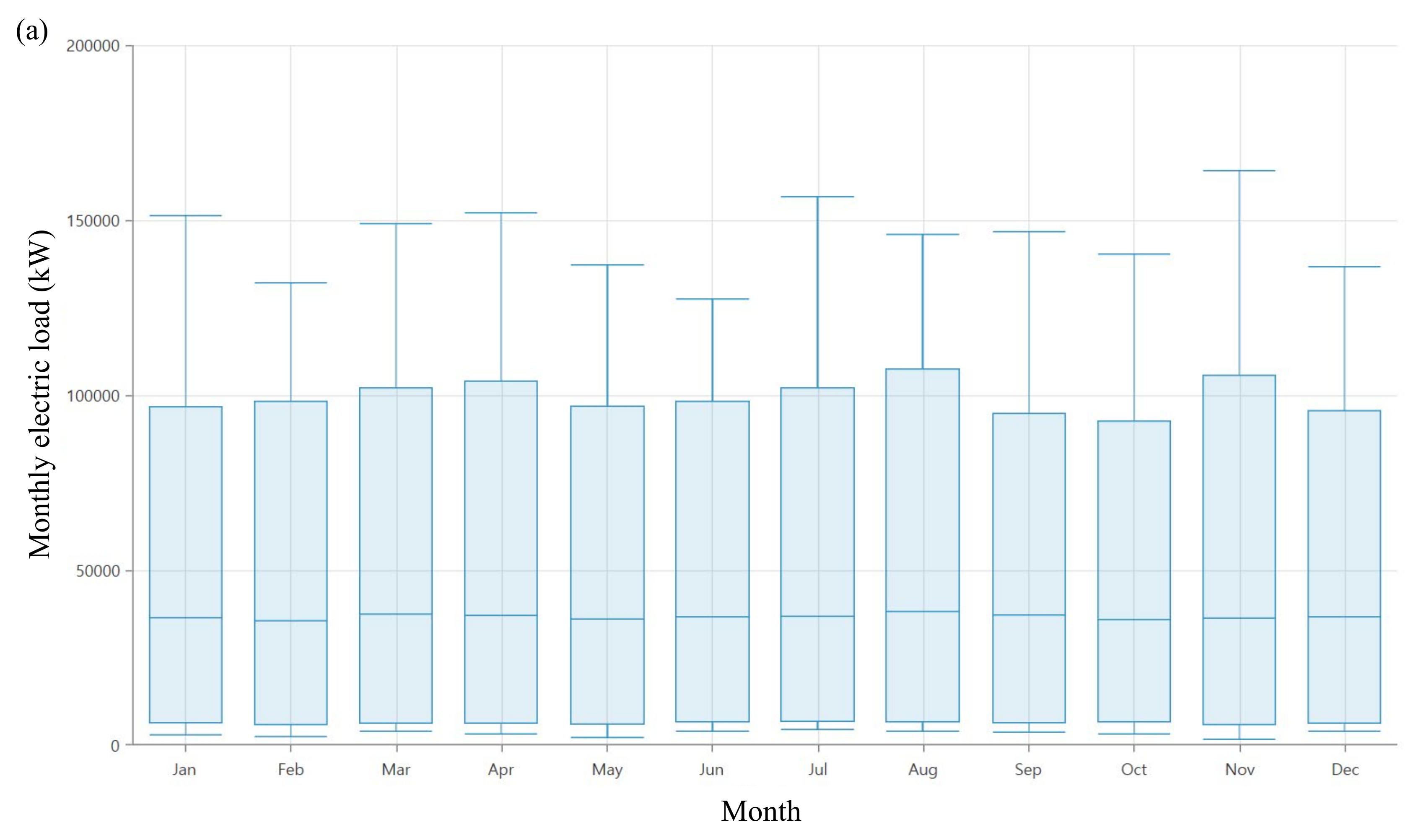
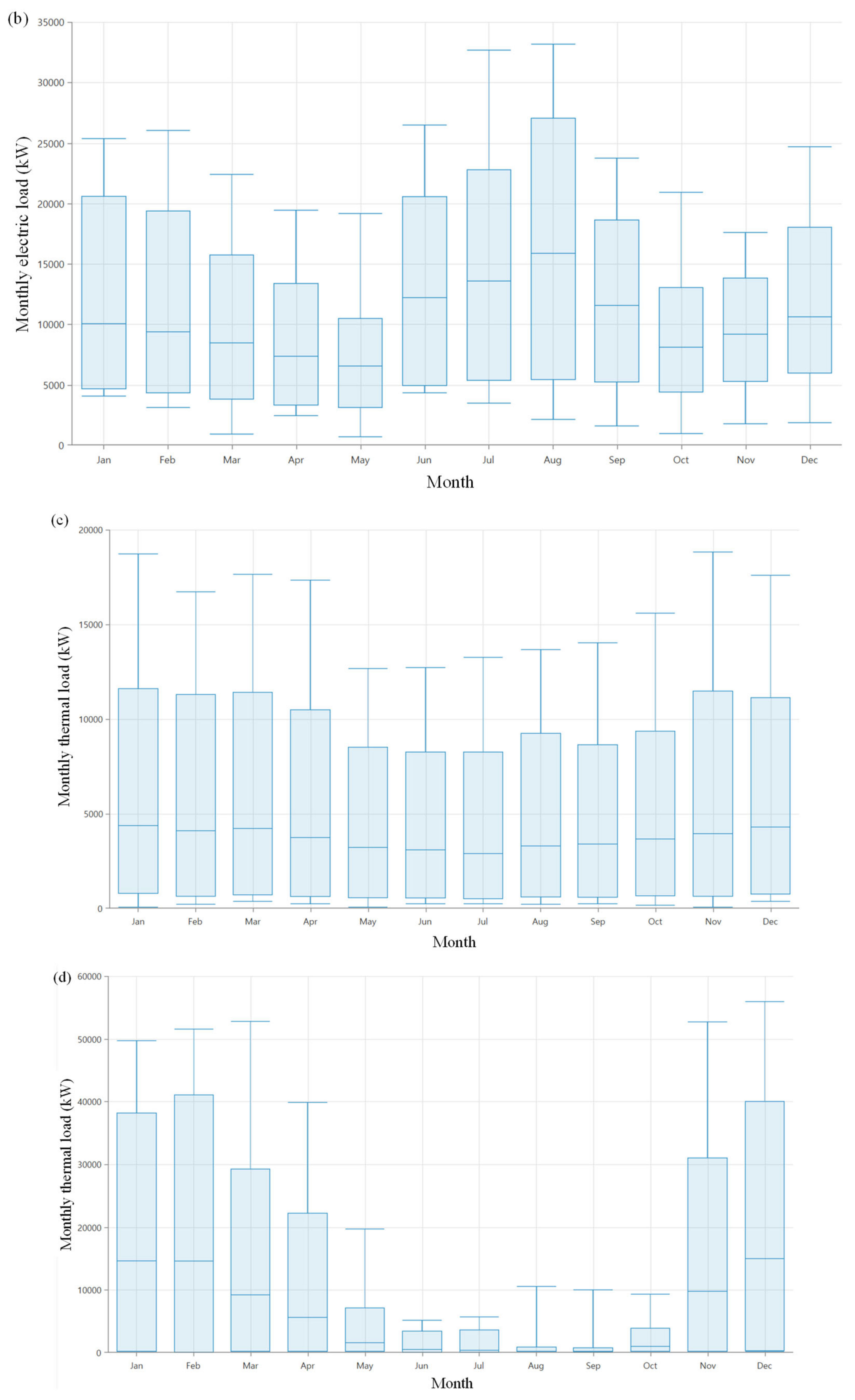
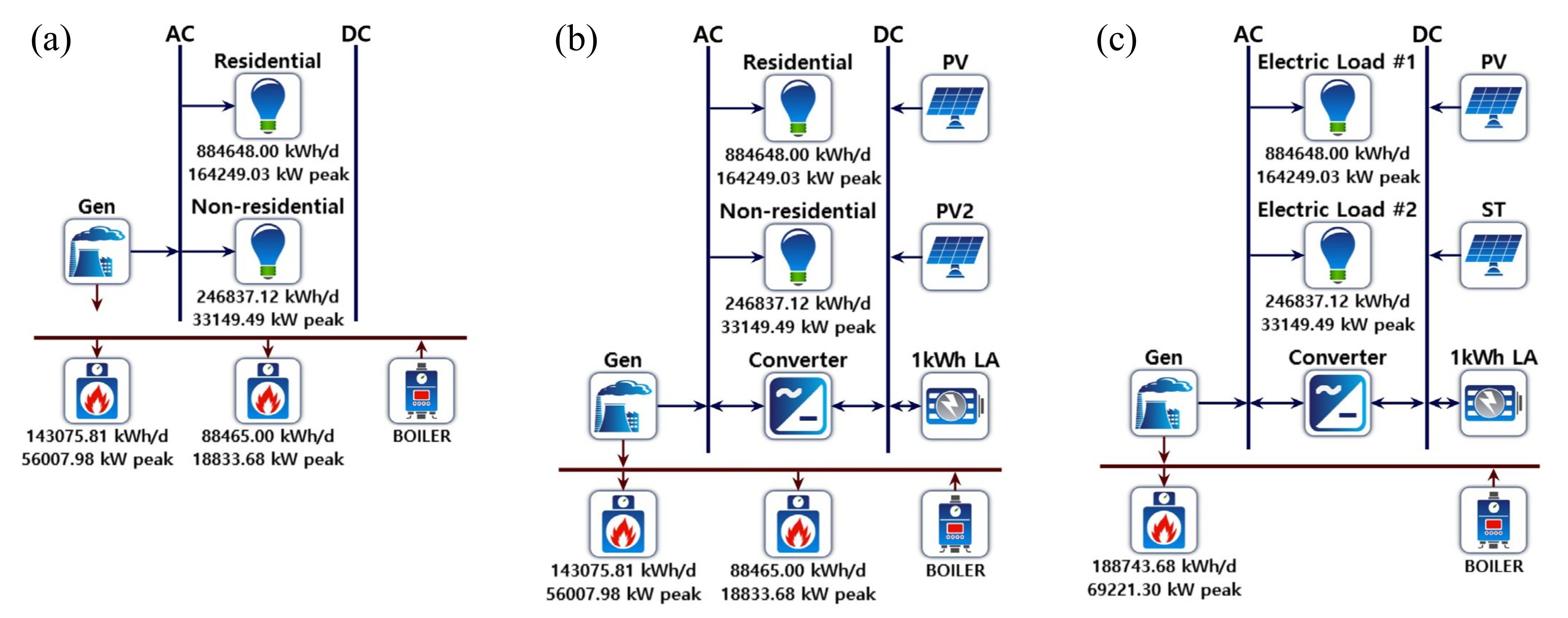
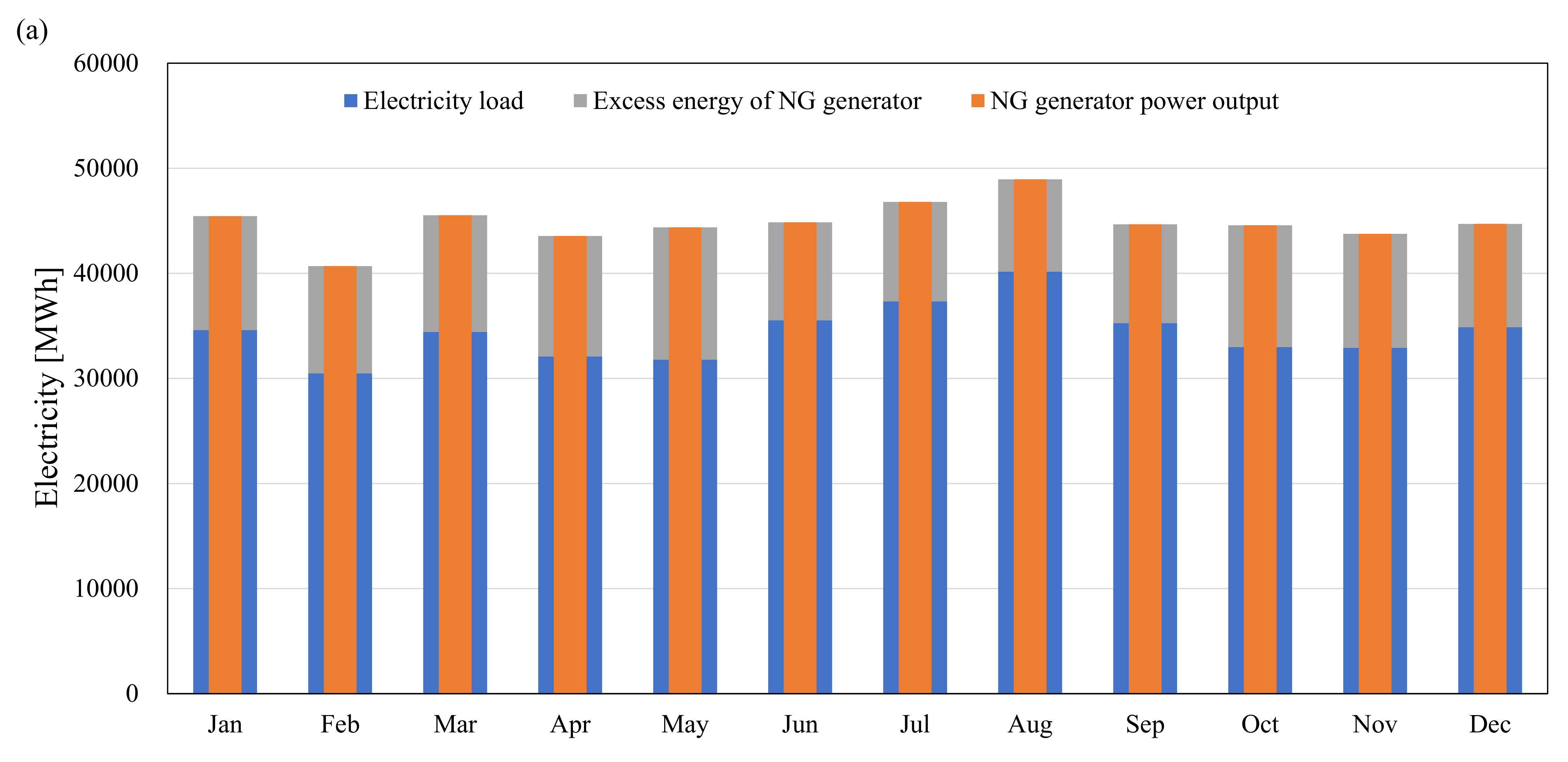
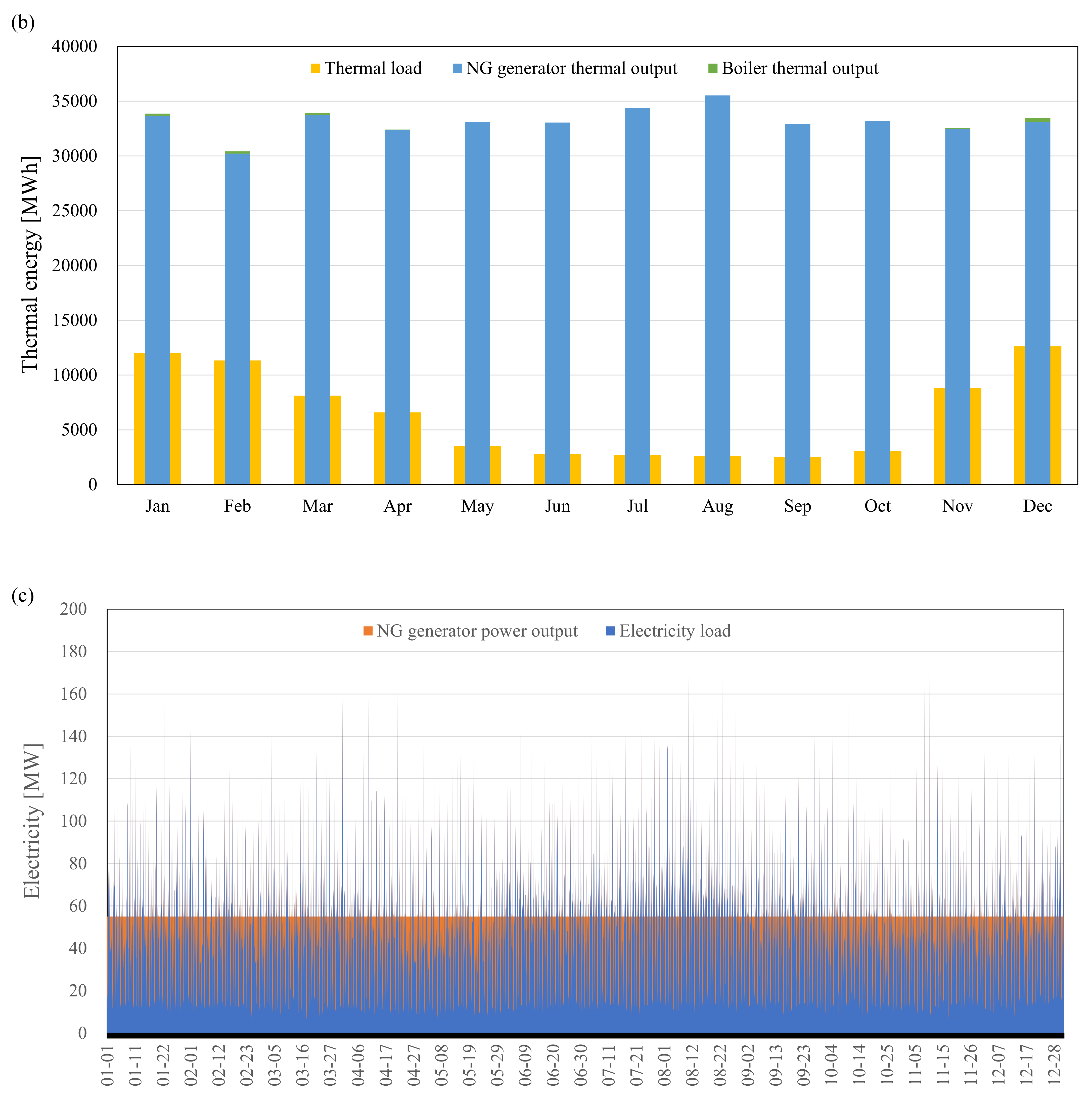
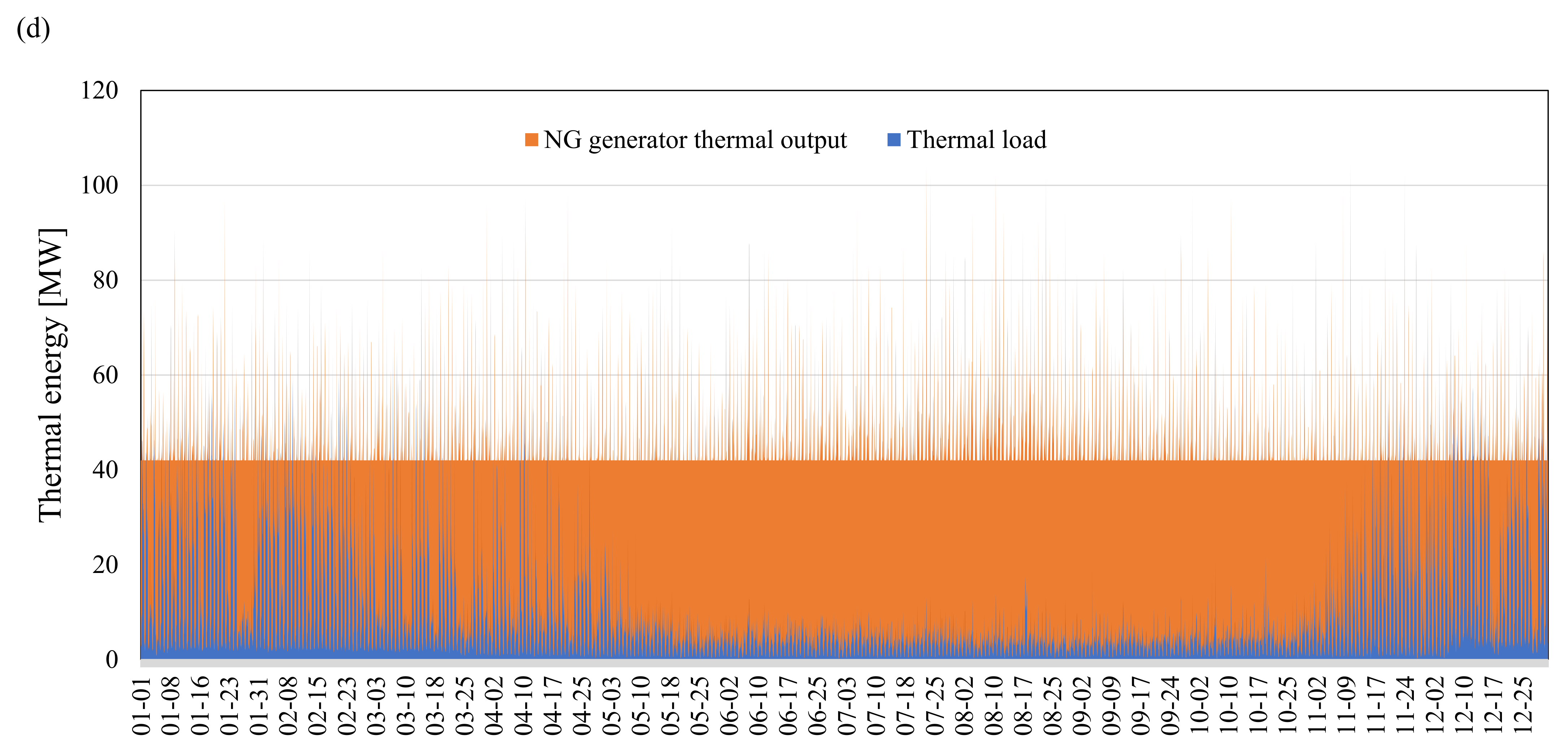
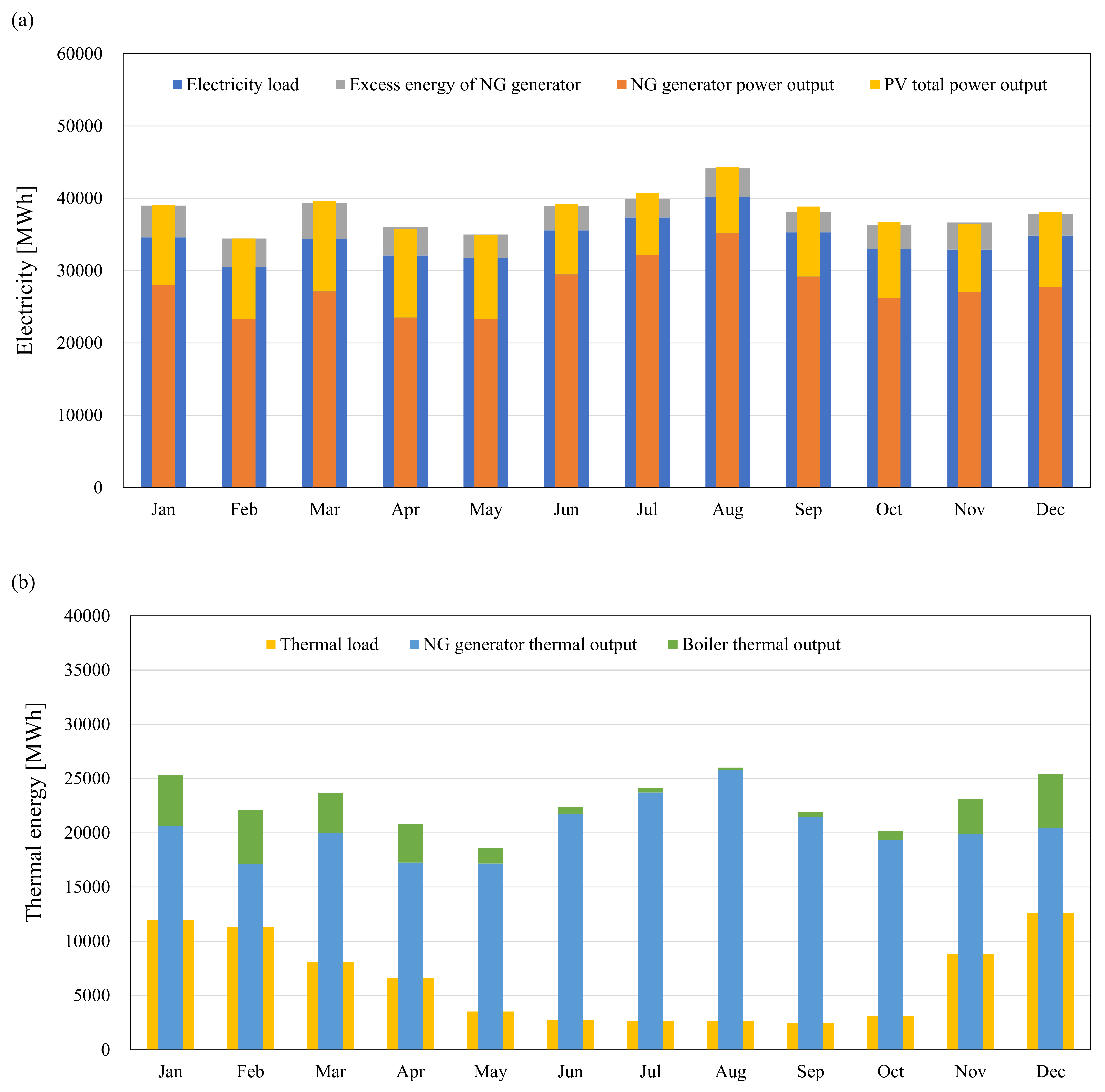
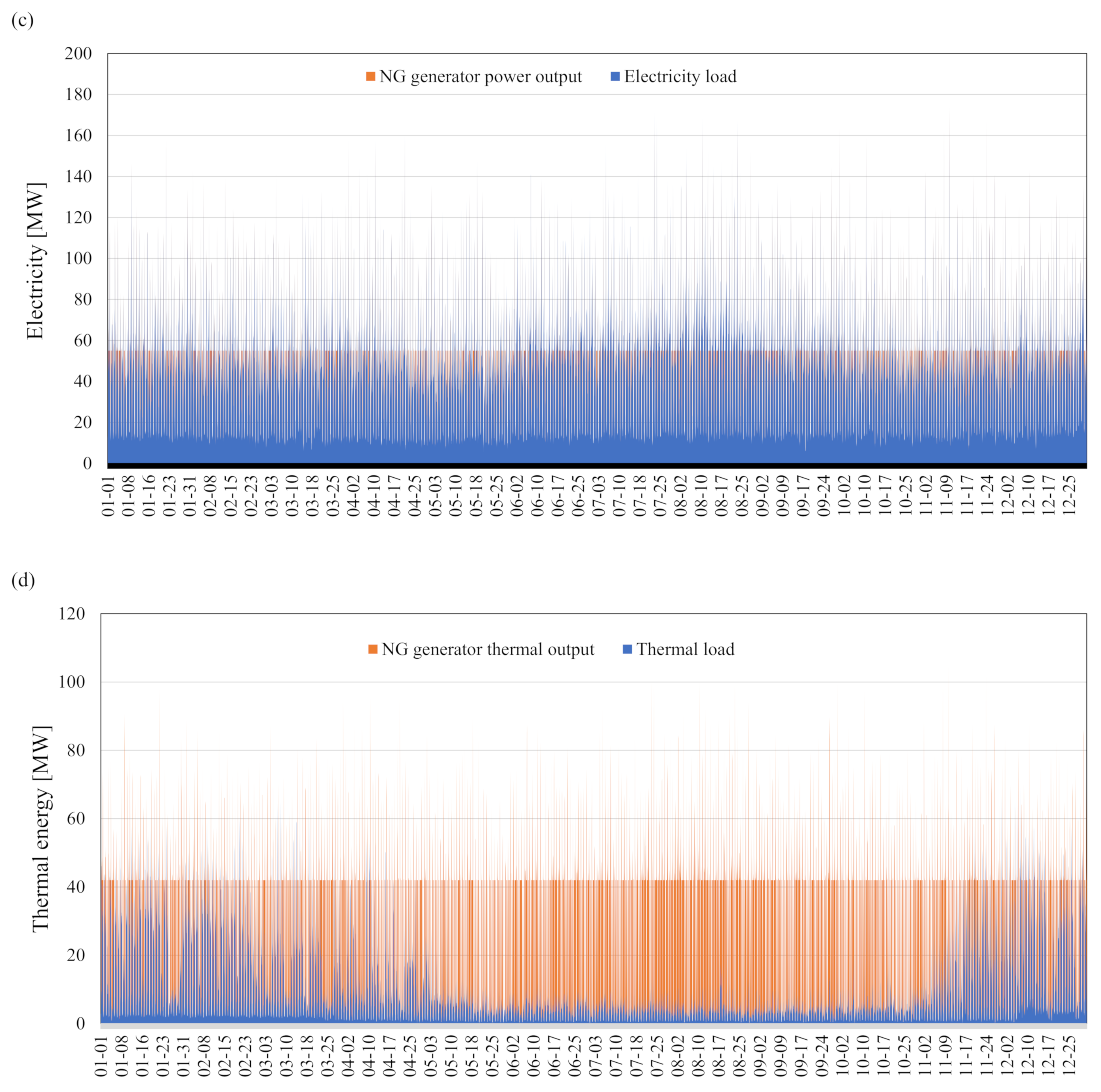
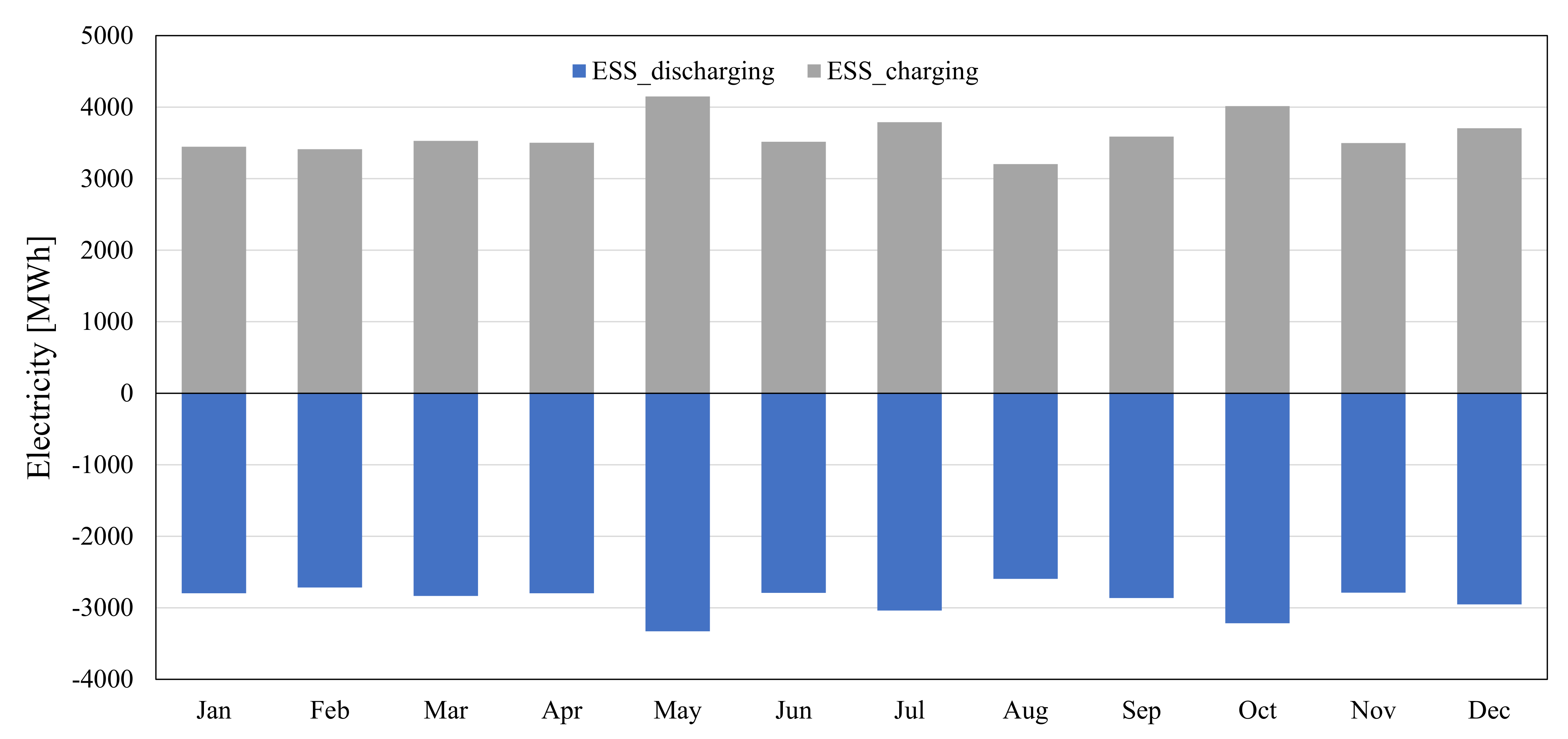
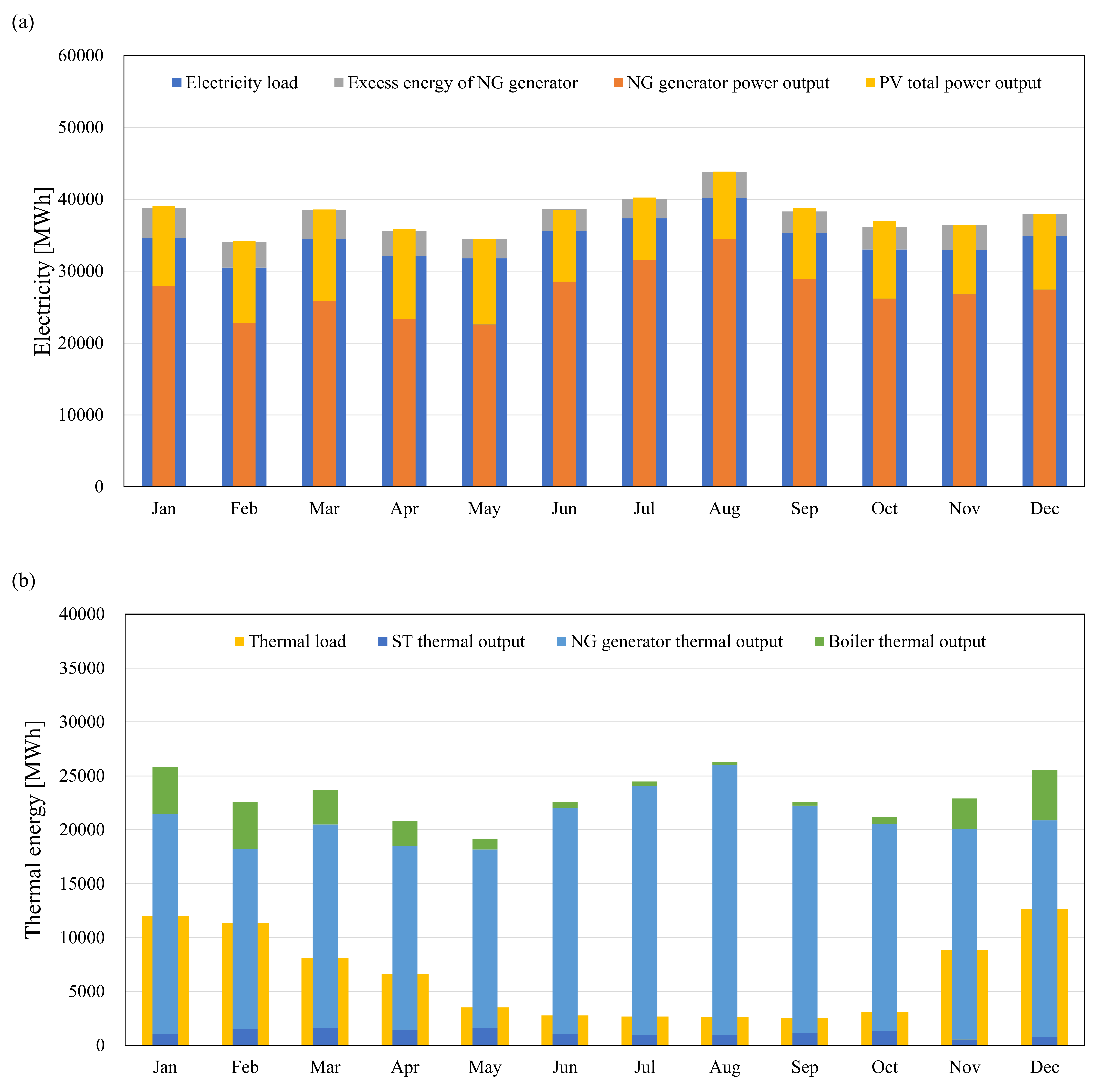

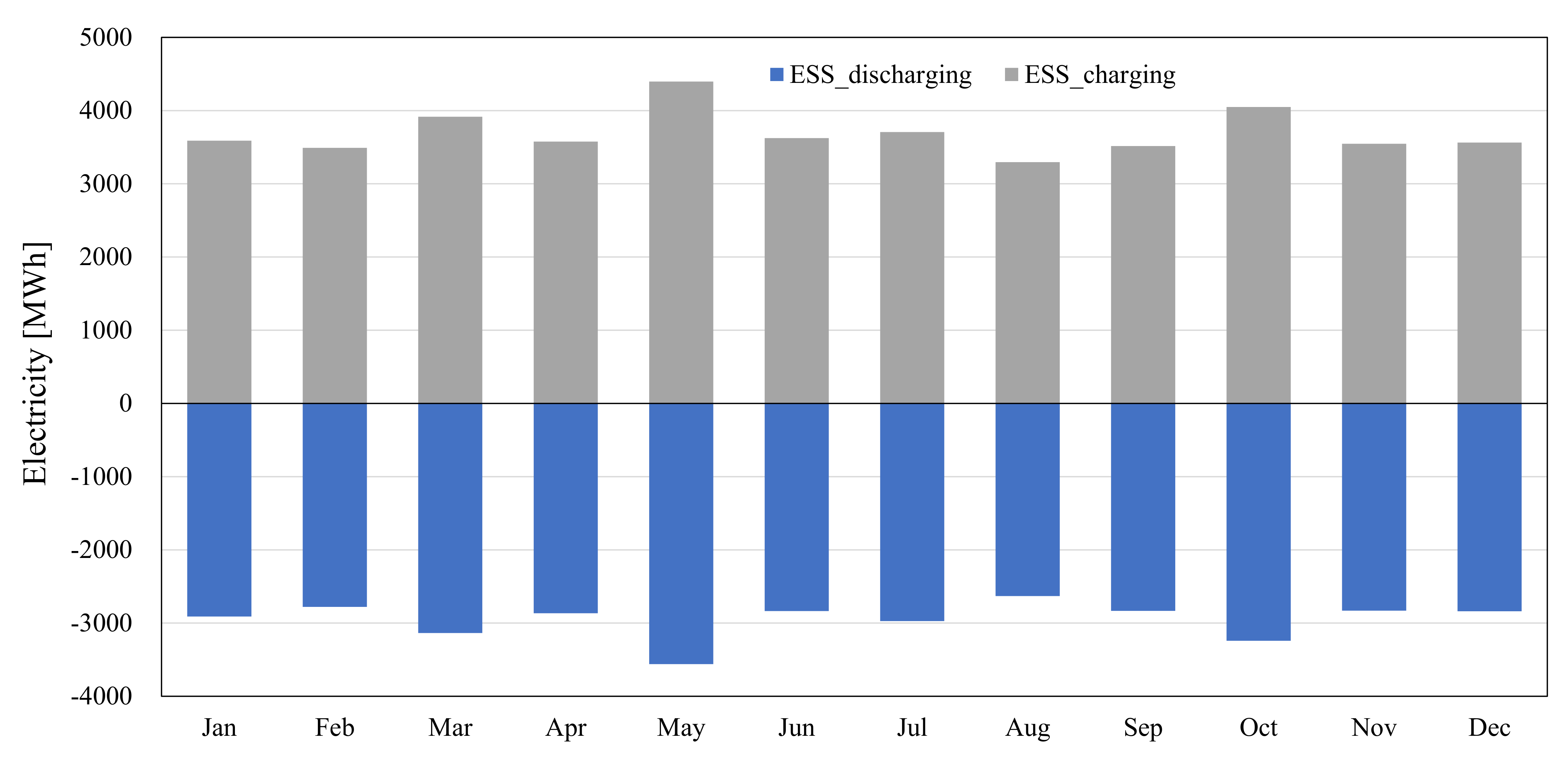
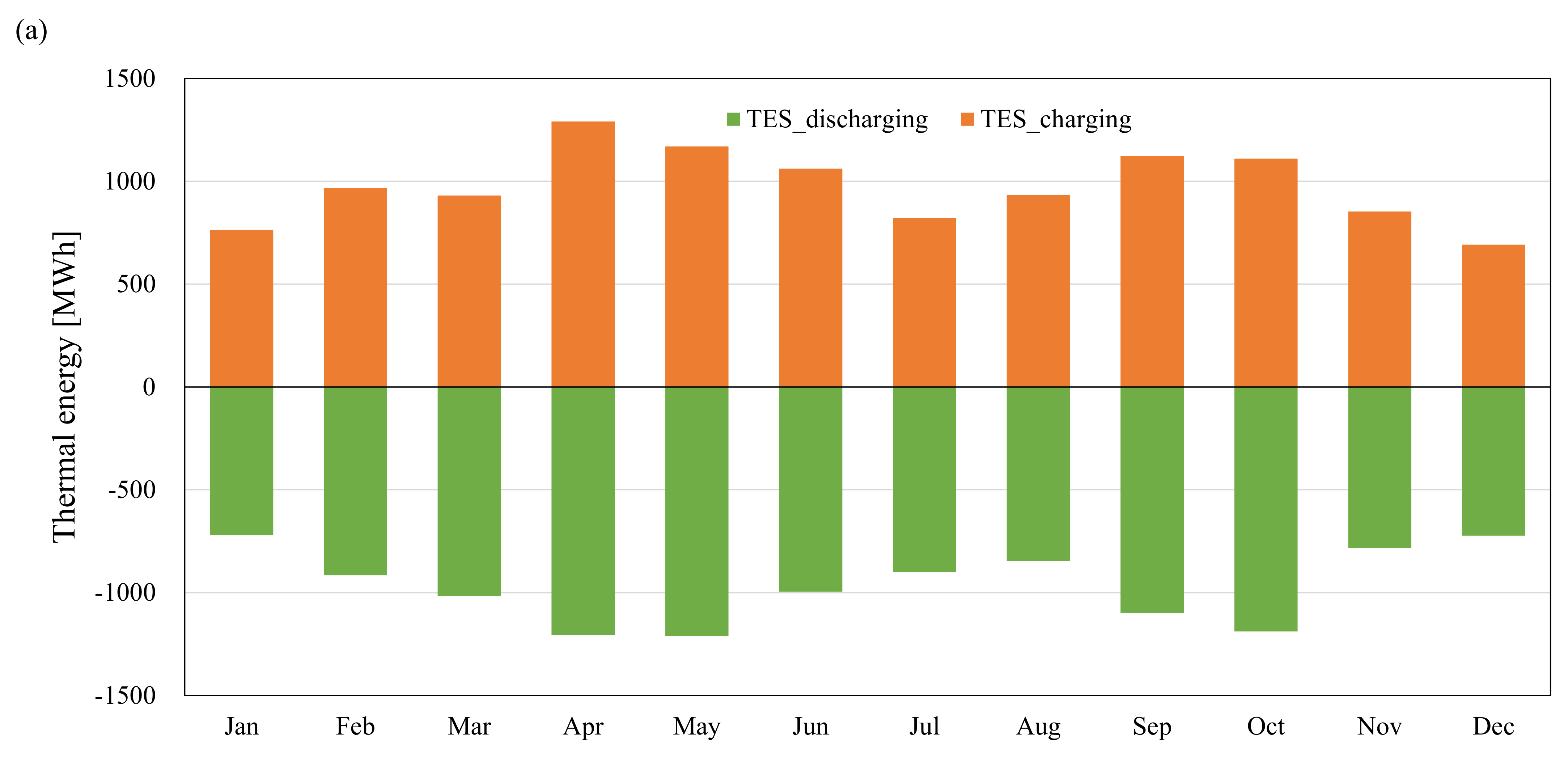
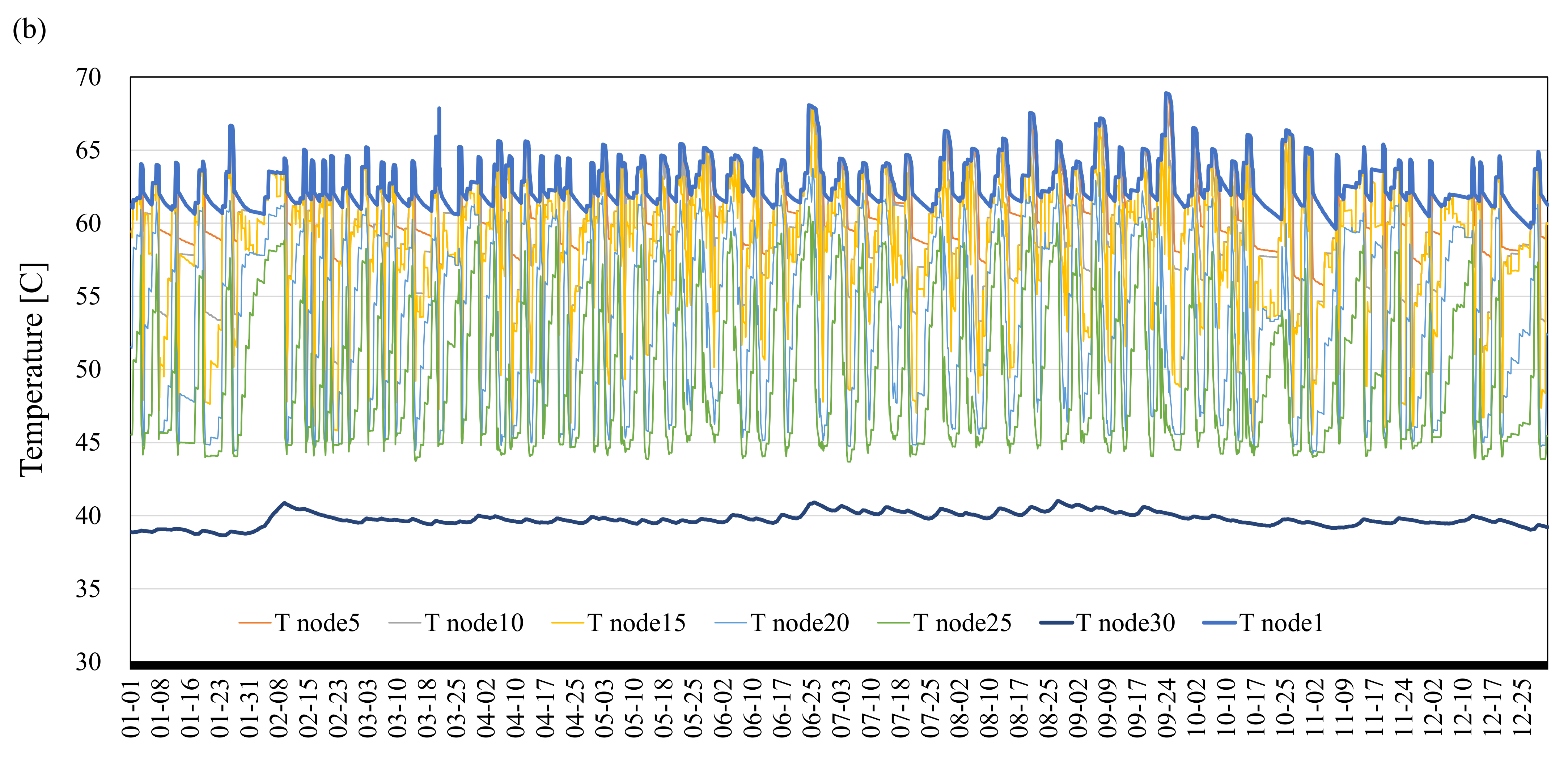
| Buildings Information | Electric Load | Thermal Load | ||||
|---|---|---|---|---|---|---|
| Total Floor Area (m2) | Total Roof Area (m2) | Daily Average (kWh/Day) | Peak (kW) | Daily Average (kWh/Day) | Peak (kW) | |
| Residential buildings | 884,648 | 174,276 | 88,465 | 164,249 | 88,465 | 18,833 |
| Nonresidential buildings | 1,214,300 | 239,218 | 246,837 | 33,149 | 143,162 | 56,007 |
| Architecture | ||||||
|---|---|---|---|---|---|---|
| NG Generator [kW] | PV-Roof [kW] | PV-Empty [kW] | ST-Empty [m2] | ESS [kW] | Inverter [kW] | |
| Base case | 220,000 | - | - | - | - | - |
| Case 1 | 220,000 | 104,201 | 3982 | - | 238,512 | 73,894 |
| Case 2 | 220,000 | 104,201 | - | 19,912 | 261,640 | 87,899 |
| Renewable Penetration Rate | Emission | Cost | ||||||
|---|---|---|---|---|---|---|---|---|
| Electric [%] | Thermal [%] | CO2 [ton] | CO [ton] | NPC [$] | CAPEX [$] | O&M [$/year] | LCOE [$] | |
| Base case | - | - | 297,461 | 2563 | 4.81B | 574M | 328M | 0.892 |
| Case 1 | 30.9 | - | 189,766 | 1579 | 4.48B | 1.23B | 251M | 0.830 |
| Case 2 | 30.5 | 5.1 | 184,752 | 1544 | 4.50B | 1.27B | 249M | 0.835 |
Publisher’s Note: MDPI stays neutral with regard to jurisdictional claims in published maps and institutional affiliations. |
© 2021 by the authors. Licensee MDPI, Basel, Switzerland. This article is an open access article distributed under the terms and conditions of the Creative Commons Attribution (CC BY) license (https://creativecommons.org/licenses/by/4.0/).
Share and Cite
Kim, M.-H.; Kim, D.-W.; Lee, D.-W. Feasibility of Low Carbon Renewable Energy City Integrated with Hybrid Renewable Energy Systems. Energies 2021, 14, 7342. https://doi.org/10.3390/en14217342
Kim M-H, Kim D-W, Lee D-W. Feasibility of Low Carbon Renewable Energy City Integrated with Hybrid Renewable Energy Systems. Energies. 2021; 14(21):7342. https://doi.org/10.3390/en14217342
Chicago/Turabian StyleKim, Min-Hwi, Deuk-Won Kim, and Dong-Won Lee. 2021. "Feasibility of Low Carbon Renewable Energy City Integrated with Hybrid Renewable Energy Systems" Energies 14, no. 21: 7342. https://doi.org/10.3390/en14217342
APA StyleKim, M.-H., Kim, D.-W., & Lee, D.-W. (2021). Feasibility of Low Carbon Renewable Energy City Integrated with Hybrid Renewable Energy Systems. Energies, 14(21), 7342. https://doi.org/10.3390/en14217342







